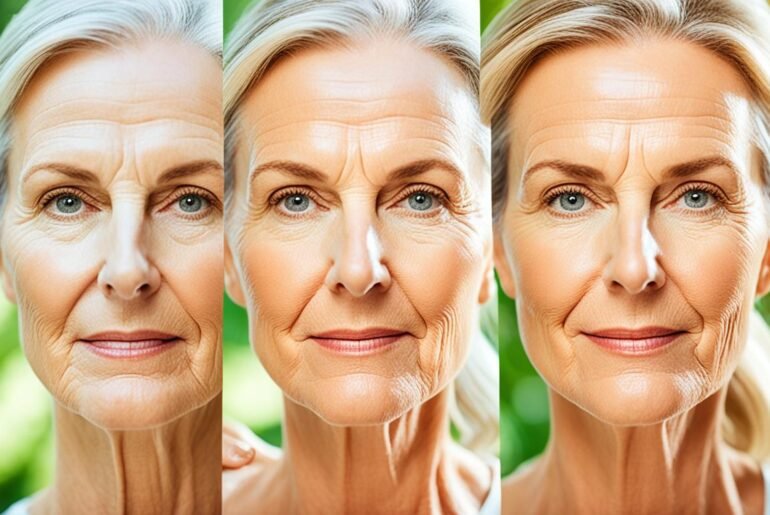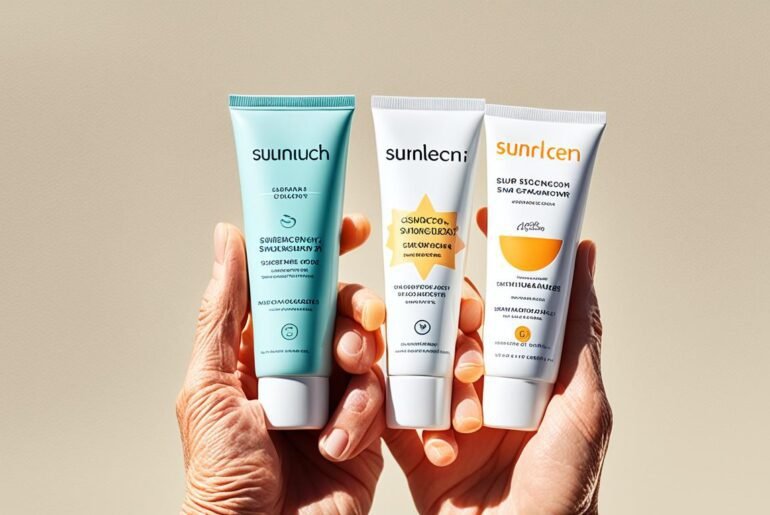Did you know that sun damage is responsible for up to 90% of visible signs of aging?1 That’s right, the sun’s harmful UV rays can cause wrinkles, fine lines, age spots, and sagging skin. Protecting your skin from the sun is crucial for maintaining a youthful and radiant complexion.
In this article, I will debunk common myths about sun protection for aging skin. We’ll separate fact from fiction and provide you with evidence-based tips and strategies for keeping your skin healthy and beautiful. Let’s dive in and discover the truth behind these sun protection misconceptions!
Key Takeaways:
- Sun damage is a major contributor to visible signs of aging.
- There are several myths surrounding sun protection for aging skin.
- Debunking these myths is crucial for effective sun damage prevention.
- Stay tuned to learn the truth about sun protection and aging skin care.
- Implementing evidence-based sun protection strategies is essential for maintaining youthful skin.
1Source: Skin Cancer Foundation
The Importance of Year-Round Sun Protection
When it comes to protecting your skin from the harmful effects of the sun, year-round sun protection is crucial. Many people mistakenly believe that they only need to use sunscreen during the summer months or on sunny days. However, UV rays can still penetrate clouds and cause damage to the skin, even in winter or on overcast days.
One common misconception is that a base tan can provide protection against the sun’s harmful rays. In reality, a base tan offers minimal protection and does not prevent skin cancer or sunburn. It’s important to prioritize sun protection measures, such as using sunscreen, regardless of whether you have a tan or not.
Even on cloudy or foggy days, UV rays can still penetrate through the clouds and fog, leading to sun damage. Snow can also reflect up to 80% of UV rays, increasing the risk of sunburn. This is why it’s crucial to wear sunscreen year-round and take precautionary measures to protect your skin.
“UV rays can still penetrate clouds and cause damage to the skin, even in winter or on overcast days.”
The FDA recommends using sunscreen with a sun protection factor (SPF) value of 15 or higher. Reapplication of sunscreen every two hours is crucial for continued protection, especially if you’re outdoors for an extended period or engaging in activities that cause sweating or swimming.
It’s also important to note that individuals with dark skin are not immune to sun damage. While darker skin tones offer some inherent protection against sunburn, sun damage can still occur, leading to premature aging and an increased risk of skin cancer. Therefore, everyone, regardless of skin color, should use sunscreen as part of their year-round sun protection routine.
| Sun Protection Tips | Benefits |
|---|---|
| Wear sunscreen with SPF 15 or higher every day, regardless of the weather. | Protects the skin from harmful UV rays and reduces the risk of sunburn and skin cancer. |
| Reapply sunscreen every two hours, or immediately after sweating or swimming. | Ensures continued protection and maximizes the effectiveness of sunscreen. |
| Wear protective clothing, such as wide-brimmed hats and sunglasses. | Further shields the skin and eyes from UV radiation. |
| Seek shade during peak sun hours (10 a.m. to 4 p.m.). | Reduces direct exposure to intense UV rays. |
Debunking SPF Myths
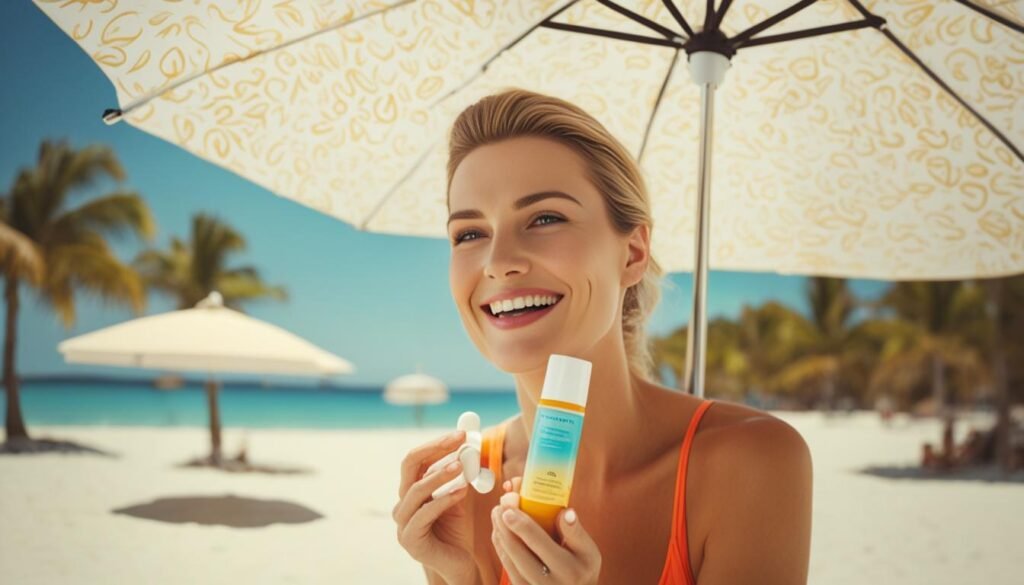
When it comes to sun protection, understanding SPF, or sun protection factor, is crucial for making informed decisions. SPF specifically indicates the level of protection against UVB rays, which are responsible for causing sunburn. Contrary to popular belief, a higher SPF does not necessarily mean superior protection.
SPF 30: adequate protection against UVB rays, blocking about 97% of them.
Although higher SPFs offer a slight increase in protection, it is important to note that no sunscreen can block 100% of UVB rays. Reapplication is necessary regardless of the SPF level to maintain effective sunscreen coverage throughout the day.
Sunscreen should be applied generously to all exposed areas of the skin and reapplied every two hours or immediately after sweating or swimming. This ensures continuous protection and minimizes the risk of sunburn or skin damage.
It’s worth mentioning that sunscreen has an expiration date. Expired sunscreen may lose its effectiveness, so it’s important to check the date before use.
Waterproof sunscreen is a myth. While some sunscreens are labeled as water-resistant, they still need to be reapplied after water exposure to maintain adequate protection against UV rays.
Maintaining the Effectiveness of Sunscreen:
- Apply sunscreen generously to all exposed areas of the skin.
- Reapply every two hours, or after sweating or swimming.
- Check the expiration date and avoid using expired sunscreen.
- Use water-resistant sunscreen, but remember to reapply after water exposure.
Debunking these SPF myths allows for a better understanding of sunscreen’s effectiveness and helps ensure the proper use of sun protection measures.
| SPF Level | Protection Against UVB Rays | Reapplication | Expiration Date | Waterproof |
|---|---|---|---|---|
| SPF 30 | Blocks about 97% of UVB rays | Every two hours or after sweating/swimming | Check expiration date | No |
| SPF 50+ | Slightly higher protection | Every two hours or after sweating/swimming | Check expiration date | No |
By adhering to these guidelines, individuals can maximize the effectiveness of sunscreen and minimize the risk of sunburn, skin damage, and long-term sun-related health issues.
Sunscreen Myths for Different Skin Types
It is a common misconception that individuals with darker skin do not need to use sunscreen. While it is true that darker skin tones have some inherent protection against sunburn, they are still susceptible to the long-term effects of UV exposure, such as premature aging and an increased risk of skin cancer.
As a professional journalist, I want to emphasize the importance of inclusive sun care practices. Sunscreen should be used by individuals of all skin tones as a universal preventive measure. It is not only about preventing immediate sunburn but also about safeguarding the skin’s long-term health.
The Myth of Sunscreen Exclusivity
Sunscreen for different skin types is essential because each skin type has different needs when it comes to sun protection. While individuals with fair or lighter skin require higher SPF levels, individuals with darker skin tones should also use sunscreen to protect against UV rays and maintain skin health.
Protecting All Exposed Areas
When considering sun care practices, it’s important to protect all exposed areas of the body, not just the face. Different parts of the body have varying levels of thickness and sensitivity to UV radiation. Wearing protective clothing, including wide-brimmed hats and clothing with UPF (Ultraviolet Protection Factor), is a crucial part of comprehensive sun care.
“It is crucial to debunk the myth that darker skin is immune to sun damage. Sunscreen should be a part of everyone’s sun care routine, regardless of their skin tone.”
Table: Sunscreen Recommendations for Different Skin Types
| Skin Type | Sunscreen Recommendation |
|---|---|
| Fair or Light Skin | Sunscreen with SPF 30 or higher |
| Medium or Olive Skin | Sunscreen with SPF 15 or higher |
| Dark or Deeply Pigmented Skin | Sunscreen with SPF 15 or higher |
The table above provides general sunscreen recommendations for different skin types. However, it is important to consult with a dermatologist to determine the best sunscreen and sun care routine for your specific needs.
By debunking the myth that only certain skin types require sunscreen, we can promote inclusive sun care practices and ensure the overall health and well-being of individuals across all skin tones.
The Limitations of Water Resistance
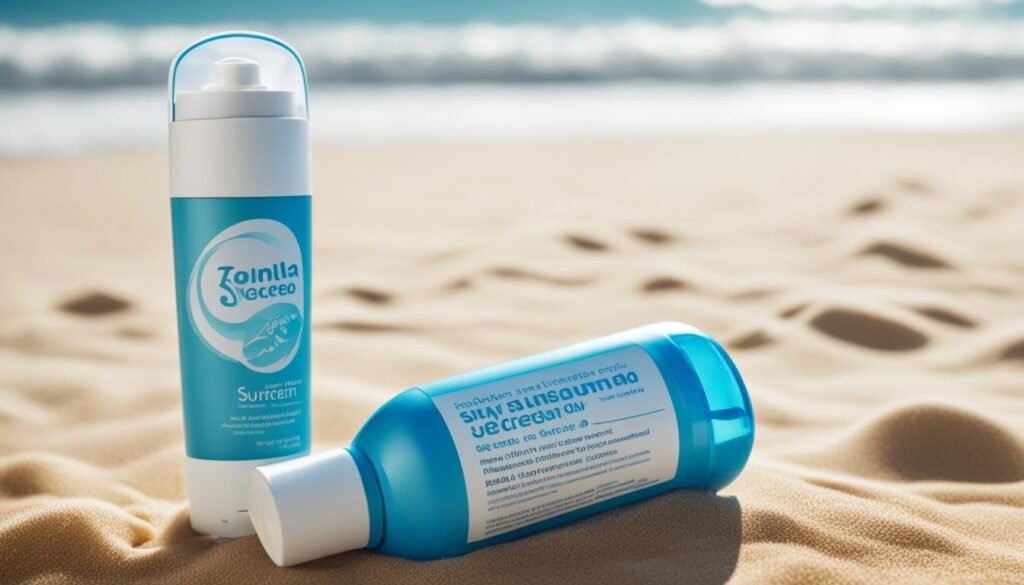
No sunscreen is entirely waterproof. Even sunscreen labeled as water-resistant can only withstand exposure to water to some extent. It is important to understand the limitations of water resistance to ensure continuous and effective sun protection.
Water-resistant sunscreen is designed to provide some level of protection while engaging in activities involving water. However, it is crucial to reapply sunscreen after swimming, sweating, or towel drying to maintain adequate protection against harmful UV radiation.
The Importance of Reapplication
Reapplication is key to ensuring continuous protection from the damaging effects of UV rays. Water-resistant sunscreen does not remain effective after prolonged water exposure or excessive sweating. By reapplying sunscreen every two hours or immediately after water activities, you can maintain the intended level of protection throughout the day. Remember that UV radiation can still penetrate the skin even when it doesn’t feel hot or sunny.
Reapplication is particularly important when engaging in water-related activities, as sunscreen can easily be washed off. Water-resistant sunscreen may offer temporary protection, but it is not a guarantee against UV radiation. To provide the most effective protection, regular reapplication is necessary, especially in high-risk situations.
An Image Illustrating Water-resistant Sunscreen
The Importance of Understanding UV Radiation
UV radiation is present year-round, even on cloudy days or during colder seasons. It is not only direct exposure to sunlight that poses a risk, but also reflected UV rays from surfaces like water, snow, and sand. Water-resistant sunscreen may offer some protection, but its effectiveness decreases with time and exposure to water.
Understanding the limitations of water-resistant sunscreen ensures that you prioritize regular reapplication and take additional measures to protect your skin from UV radiation.
| Water Exposure | Effectiveness of Water-resistant Sunscreen |
|---|---|
| Light splashing or water exposure | May provide some protection |
| Swimming, excessive sweating, or towel drying | Significantly reduces effectiveness, requiring reapplication |
| Prolonged water exposure | Minimal to no protection left |
Beyond Sunscreen: Additional Sun Protection Measures
While sunscreen is essential for protecting the skin from harmful UV radiation, it should not be the only form of sun protection. Taking additional measures can enhance your sun protection routine and reduce the risk of sun damage. Here are some key steps you can incorporate:
Sunglasses:
Don’t forget to protect your eyes from the sun’s rays. Wearing sunglasses with UV protection helps shield your eyes from harmful UV radiation. Look for sunglasses with a high level of UVB and UVA protection to ensure maximum sun protection for your eyes.
Wide-Brimmed Hat:
A wide-brimmed hat is a stylish and effective way to shield your face, neck, and ears from the sun. Opt for a hat with a brim that provides adequate shade and covers vulnerable areas. This added protection can help minimize sunburn and reduce the risk of long-term sun damage.
UPF Clothing:
Consider incorporating UPF (Ultraviolet Protection Factor) clothing into your wardrobe. UPF clothing is specifically designed to block harmful UV rays, providing an additional layer of protection for your skin. Look for clothing with a high UPF rating to ensure optimal sun protection.
Avoid Peak Sun Hours:
Try to avoid sun exposure during the peak hours of the day, typically between 10 a.m. and 4 p.m. During these hours, the sun’s rays are the strongest, increasing the risk of sunburn and other sun-related skin damage.
These additional sun protection measures can be used in conjunction with sunscreen to provide comprehensive and effective sun protection. By incorporating these steps into your daily routine, you can help reduce the risk of sun damage and maintain healthier skin.
Remember, regular skin checks and consultations with a dermatologist are also crucial for timely detection of any skin changes or abnormalities. Stay proactive in protecting your skin from the sun’s harmful effects.
“Protecting your skin from the sun’s rays goes beyond just sunscreen. Sunglasses, a wide-brimmed hat, and UPF clothing are essential sun protection accessories.”
| Additional Sun Protection Measures | Description |
|---|---|
| Sunglasses | Protects the eyes from harmful UV radiation |
| Wide-Brimmed Hat | Shields the face, neck, and ears from the sun |
| UPF Clothing | Blocks UV radiation and provides added sun protection |
| Avoid Peak Sun Hours | Minimizes sun exposure during the strongest hours of UV radiation |
The Importance of Sun Protection for All Ages

Many believe that most sun exposure occurs during childhood and adolescence. However, studies have shown that less than 25% of a person’s lifetime sun exposure occurs before adulthood. This highlights the ongoing importance of sun protection throughout all stages of life.
Sun protection measures are crucial for everyone, regardless of age, to lower the risk of skin cancer and prevent premature skin aging. The harmful effects of UV radiation can accumulate over time, leading to long-term damage. Incorporating sun protection into daily routines is essential for maintaining long-term skin health.
Children, in particular, are more vulnerable to the damaging effects of the sun due to their sensitive skin. It is important for parents and caregivers to prioritize sun protection for their little ones. Using sunscreen with a high sun protection factor (SPF), protective clothing, hats, and sunglasses are all important measures to ensure their safety under the sun.
“Sun protection is not just for children. It is equally important for adults and seniors to take care of their skin and protect themselves from harmful UV radiation.”
In fact, adults and seniors are also at risk of sun damage. As we age, our skin becomes more susceptible to the harmful effects of the sun, increasing the chances of skin cancer and premature aging. Therefore, sun protection should be a priority for people of all ages.
Remember, wearing sunscreen with an appropriate SPF, seeking shade during peak sun hours, wearing protective clothing, and regularly checking your skin for any changes are all essential components of an effective sun protection routine. By taking these measures, you can safeguard your skin and prevent sun damage for a healthier and more youthful complexion.
Sun Protection Tips for All Ages
| Age Group | Sun Protection Tips |
|---|---|
| Children |
|
| Adults |
|
| Seniors |
|
The Role of Vitamin D and Sun Protection

While the sun is a major source of vitamin D, it’s important to balance the need for sun protection with vitamin D intake. Fortunately, there are other ways to obtain this essential nutrient, such as through diet, multivitamins, and supplements.
Foods rich in vitamin D include:
| Dietary Sources of Vitamin D |
|---|
| Fatty Fish |
| Cheese |
| Egg Yolk |
| Fortified Milk |
| Liver |
By incorporating these vitamin D-rich foods into your diet, you can support your overall health and wellness while still practicing sun protection. It’s important to note that sun protection practices should not be compromised, as excessive sun exposure can lead to sunburn, skin aging, and an increased risk of skin cancer.
The Benefits of Comprehensive Sun Care
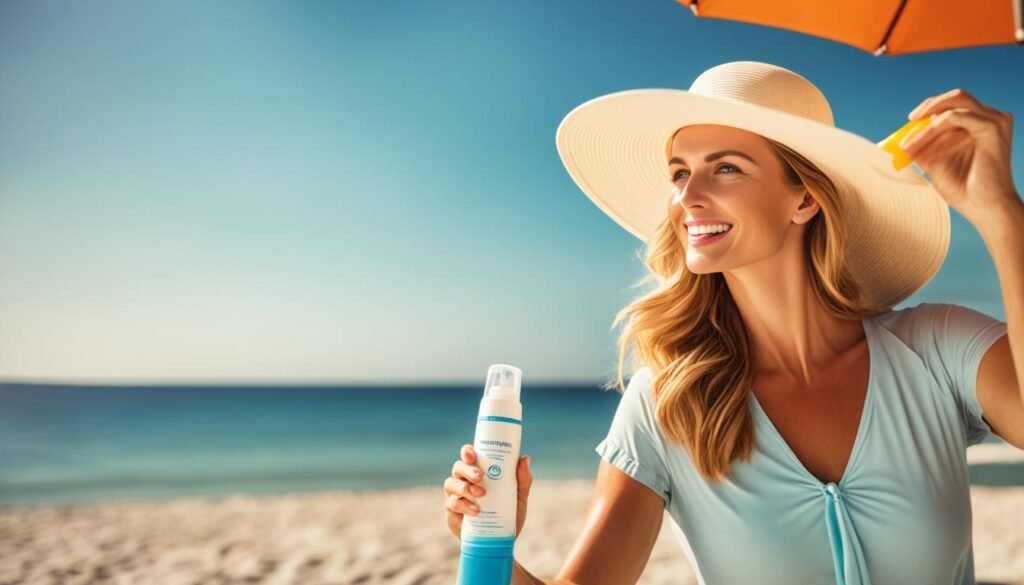
A comprehensive sun care routine is essential for protecting your skin from harmful UV rays and maintaining its health and vitality. By incorporating sunscreen, protective accessories, regular skin checks, and consultations with a dermatologist, you can enjoy numerous benefits that go beyond skin protection.
First and foremost, a comprehensive sun care routine significantly reduces the risk of developing skin cancer. UV radiation is a leading cause of various types of skin cancer, including melanoma. By consistently protecting your skin from the sun’s harmful rays, you can minimize the chances of developing this potentially life-threatening disease.
In addition to skin cancer prevention, comprehensive sun care also helps to prevent premature skin aging. Prolonged exposure to the sun can result in the breakdown of collagen and elastin fibers, leading to sagging skin, wrinkles, and sunspots. By diligently applying sunscreen and taking other protective measures, you can maintain a more youthful and radiant complexion.
A comprehensive sun care routine is particularly beneficial in preserving the health and appearance of delicate areas such as the face, neck, and hands, which are often prone to sun damage. By incorporating protective accessories like wide-brimmed hats and sunglasses, you can shield these areas from the sun’s harmful rays and reduce the risk of developing sunspots, fine lines, and wrinkles.
To ensure optimal skin health, regular skin checks and consultations with a dermatologist are essential. These professionals can identify any early signs of sun damage or skin abnormalities and provide appropriate treatments and recommendations. By staying proactive in your sun care routine, you can address any concerns promptly and take necessary steps to protect and enhance your skin.
Investing in a comprehensive sun care routine is a long-term investment in your skin’s health and overall well-being. By prioritizing skin protection, you can enjoy the benefits of a reduced risk of skin cancer, prevention of premature aging, and a radiant, youthful complexion. Make sun care a daily habit, and reap the rewards of healthy and beautiful skin.
Conclusion
In conclusion, effective sun damage prevention is crucial for maintaining healthy skin and debunking common sun protection myths. To protect your skin from harmful UV radiation, it is essential to use sunscreen with an appropriate SPF on a daily basis. Regular reapplication of sunscreen every two hours, especially after sweating or swimming, ensures continued protection throughout the day.
However, sunscreen alone is not enough to shield your skin from sun damage. Comprehensive sun protection measures, such as wearing sunglasses and a wide-brimmed hat, seeking shade during peak sun hours, and wearing UPF clothing, further reduce the risk of sunburn, premature skin aging, and skin cancer.
Furthermore, regular skin checks and consultations with a dermatologist play a crucial role in the early detection and prevention of sun damage. By incorporating these measures into your sun care routine, you can effectively protect your skin and maintain its health and radiance for the long term.
FAQ
What are some common myths about sun protection for aging skin?
Some common myths about sun protection for aging skin include thinking that sunscreen is only necessary on sunny days, that overcast or cloudy days protect against UV rays, and that individuals with darker skin tones do not need sunscreen.
Why is year-round sun protection important?
Year-round sun protection is important because UV rays can penetrate through clouds and windows, and snow can reflect up to 80% of UV rays. Sunscreen should be used daily to prevent sunburn, premature skin aging, and skin cancer.
What is SPF and what does it indicate?
SPF stands for sun protection factor and indicates the level of protection against UVB rays, which cause sunburn. An SPF of 30 blocks about 97% of UVB rays. Higher SPFs offer a slight increase in protection, but reapplication is still necessary regardless of the SPF level.
Do individuals with darker skin tones need sunscreen?
Yes, individuals with darker skin tones still need sunscreen as they are susceptible to the long-term effects of UV exposure, including premature aging and skin cancer. Sunscreen should be used by individuals of all skin tones as a universal preventive measure.
Is water-resistant sunscreen enough for water activities?
No, water-resistant sunscreen is not enough for water activities. While it can withstand exposure to water to some extent, it still needs to be reapplied after swimming, sweating, or towel drying to maintain adequate protection against UV rays.
Are there other forms of sun protection besides sunscreen?
Yes, besides sunscreen, sunglasses, a wide-brimmed hat, and UPF clothing are also important for protecting the skin and eyes from UV radiation. Avoiding the sun during peak hours of the day further reduces the risk of sun damage.
Is sun protection important for all ages?
Yes, sun protection is important for all ages. Less than 25% of lifetime sun exposure happens before adulthood, highlighting the ongoing importance of sun protection throughout life to lower the risk of skin cancer and prevent premature skin aging.
Can I get enough vitamin D without sun exposure?
Yes, there are other ways to obtain vitamin D, such as through diet, multivitamins, and supplements. Foods rich in vitamin D include fatty fish, cheese, egg yolk, fortified milk, and liver. Balancing the need for sun protection with vitamin D intake is important for overall health and wellness.
What are the benefits of a comprehensive sun care routine?
A comprehensive sun care routine, including sunscreen, protective accessories, regular skin checks, and consultations with a dermatologist, reduces the risk of skin cancer, premature aging, sagging, wrinkles, and sunspots. It ensures healthy and radiant skin.



